by Monica Brinkley | Apr 14, 2017
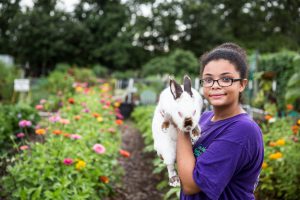
Rabbits are a popular small animal project- but is it a good fit for your family?
With spring in the air, you may be interested in getting a real live bunny. There are a few things to consider before bringing a bunny into your family:
- First consider what purpose you have for the rabbit. Do you want a pet, a rabbit to show, a rabbit to breed, or one for meat? Depending on how you answer the question will depend on what breed you choose. There are many options. The American Rabbit Breeders Association recognizes around 47 different breeds.
- Rabbits come in various sizes, shapes, fur types, and colors. Rabbit range from 2 to 20 pounds. There are several fur types to consider with normal fur being most common to unique fur that require special consideration. Satin fur is known for its luster and sheen. Angora fur is distinctive because of its length and its woolen consistency. Rex fur is a dense fur type, noted for its velvet softness and thickness.
- There are five shapes of rabbits: commercial, compact, full arch, semi-arch, and cylindrical. The most common is the commercial shape. This type is found most often in meat rabbits. The compact is similar to the commercial but has a shorter, more compact body. A rabbit that has a full arch shape is taller than they are wide and have longer limbs. Semi-arch breeds are not as common, are pear-shaped. The cylindrical shape is only found in only one bread, are long and slender.
- Rabbits have an array of color. Some breeds are only recognized in one color and other breeds are recognized in multiple colors. It would be helpful for you to spend time reading about the different breeds as well as spending time with breeders or others who have rabbits. Make sure you look for healthy and lively rabbits who have glossy coats, clear, bright eyes, and clean teeth and ears.
- Rabbits are fun to keep buy need lots of care and daily exercise. They need a roomy cage to in live. Do not use a cage with a wire bottom as the wire hurts their paws. Cages should be washed out once a week with warm, soapy water and rinsed with clean water. Rabbits are like us, they don’t like living in dirty cages. Remove wet bedding and droppings every day. Keep unscented wood shavings in the bottom of the cage. They should have fresh water and hay available at all time. Food should be put in heavy bowls so that they cannot tip them over and fed two small meals a day. Wash their water bottle and food bowls every day.
- Rabbits can be a lot of fun as they are friendly and love to be stroked. You must be a good pet owner and learn to look after your rabbits properly, they may live for up to 10 -12 years. Caring for a rabbit will help you learn how to be responsible for a living animal and how to treat animals properly.
Check with your local 4-H office to see if there is a rabbit club for you to join. You may choose to join the club to become more knowledgeable about rabbits before you become an owner. You then would be able to make informed decision about the perfect breed for you and your family. If you have a passion for rabbits, consider becoming a 4-H rabbit project leader to inspire the next generation of rabbit owners and breeders. Contact your local UF IFAS County Extension Office or visit florida4h.org for more information.
4-H Rabbit Project Page
Online 4-H Rabbit Project Book
North Florida Fair Rabbit Show
by Monica Brinkley | Feb 12, 2016
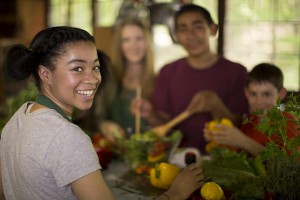
Making family meal time a priority can increase your children’s self esteem.
In a recent book entitled The Surprising Power of Family Meals, author Miriam Weinstein asks this question:
“What if I told you that there was a magic bullet-something that would improve the quality of your daily life, your children’s chances of success in the world, (and) your family’s health…? Something that is inexpensive, simple to produce, and within the reach of pretty much everyone? (Weinstein, 2005, p. 1)”
You guessed it, that magic bullet is the family meal! According to research, eating together as a family on a regular basis has some surprising effects. When sharing a meal together family bonds become stronger, children are better adjusted, family members eat more nutritional meals, they are less likely to be overweight, and they are less likely to abuse alcohol or other drugs. Given the positive benefits of eating together, why are more families not doing it?
It may come as a surprise to you that 71% of older children and teenagers consider talking/catching-up, and spending time with family members as the best part of family dinners. Family meals are a representation of the ethnic, cultural, or religious heritage of the family (Weinstein, 2005). A study found that children who knew a lot about their family history had a closer relationship to family members, higher self-esteem, and a great sense of control over their own lives (Duke, Fivush, Lazarus, & Bohanek, 2003).
With this in mind, why not make shared family meals a priority. Emphasize the importance of being together, not creating an elaborate meal that everyone will enjoy. Set regular meal times by writing them on the calendar. Let everyone know when dinner is served and when they must be home.
If the family is not used to eating together regularly, start small. At first, get used to eating together by scheduling family meals two or three days per week. Then, as the weeks progress, begin to have more and more regular meals.
Make family meals fun. Include children in the preparation of the meal and in the decision about what foods will be offered during the meal. Of course, parents have final say about what foods are prepared, but allowing the children to participate can create a fun environment.
- Keep a sense of humor while at the dinner table.
- Eliminate distractions, like TV, telephone, and cell phones.
- Limit conversations to positive or neutral topics.
- Be a good role model. Show children good etiquette and table manners.
Eating together as a family is more than just a meal, it is an opportunity for families to come together regularly in support of family unity. Although there is no guarantee that eating together as a family will resolve all family problems, it may provide the opportunity to make a fresh start. Do you have a passion for meal preparation or etiquette that you would like to share with the next generation? Consider becoming a 4-H Volunteer! Visit our website or contact your local UF IFAS Extension Office.
For the more information on this topics please visit the EDIA website at http://edis.ifas.ufl.edu, FCS8871.
Source Family Nutrition: The Truth about Family Meals, Larry Forthun
by Monica Brinkley | Nov 25, 2015
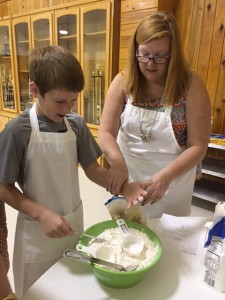
A Liberty County mother and son participate in the UF IFAS Extension Rediscover Bread Baking And Jam-Making Workshop.
Many years ago, a young girl attended a 4-H livestock club meeting along with her brothers and her father, who was serving as the volunteer club leader. During the meeting the local county 4-H Agent paid the club a visit to talk to the members about participating in the upcoming 4-H County Events Contest. The agent shared different project areas and types of demonstrations and speeches that could be done. Up until that point, the 4-H member had not been exposed to any projects outside the realm of livestock.
The agent had brought a colorful Fleishman’s Yeast Bread Cookbook that caught the eye of the young girl (at that time, Fleishman’s Yeast was a national sponsor for the 4-H Breads Project). The girl went home excited and told her mother that she wanted to do a demonstration on yeast breads. Her mother smiled and said, “I’ve never made yeast bread, but we will give it a try.” The 4-Her and her mom began practicing and discovered great success at baking yeast breads, so the girl began organizing her food preparation demonstration.
The 4-H breads category was very popular that year with a record number of competitors, but that didn’t scare this member. She won the county and district contests her first year competing which pushed her on to state competition in which she placed third in the state. For this 4-H member who had struggled in school, much needed confidence began to grow. From that point on she began considering a career as an Extension Agent.
After high school, this young lady went on to college and obtained a degree in Home Economics. She has served 30 years as an Extension Agent encouraging youth to be all that they can be in whatever their interests and desires. Yeast breads have been a vehicle for this agent to teach people many life lessons and skills. You may know this agent as Monica (Lewis) Brinkley, UF/IFAS Extension Liberty County Extension Director.
In honor of November, National Bread Month, and the fond memories of learning to bake yeast breads with her late mother, Monica and her Family and Consumer Sciences colleagues across the Florida Panhandle have put together a workshop titled, Rediscover Bread Baking And Jam-Making to teach families how to make bread in a bag and preserve jam. The families work together and carry home whole wheat yeast bread and preserved jam to enjoy together. Although the bread and jam do not last long, the memories created and skills learned will last a lifetime. If you are interested in this workshop or other workshops similar to this, please contact your local UF IFAS Extension Office or visit http://florida4h.org. You never know where this may take you or a member of your family!
by Monica Brinkley | Jul 10, 2015
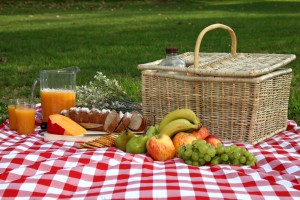
Keep your picnics safe this summer!
Summer months are a great time for picnicking with family and friends. Flies and other insects can be rather annoying, but the “bugs” you can’t see can be extremely harmful. Bacteria love the warm humid weather and grow more quickly in the summer than any other time of the year. The number of people who get sick during the hot months of the year is much greater. So read over the following tips to beat bacteria at your summer picnic.
Keep it Clean!
■ Find out if your picnic destination has a source of safe drinking water. If not, bring water or moist towelettes for cleaning hands and surfaces.
■ Always wash your hands with warm, soapy water for 20 seconds before and after handling food. Unwashed hands are a major cause of foodborne illness. Use moist towelettes if hand-washing facilities are not available.
■ Be sure raw meat and poultry are wrapped securely to prevent their juices from cross-contaminating other foods in the cooler.
■ Pack enough clean utensils for both eating and serving food. Don’t use the same utensil or platter for raw and cooked meat and poultry. Disposable plates and utensils help prevent cross-contamination.
■ Keep foods covered to prevent insects from enjoying your lunch!
Keep Cold Foods Cold!
■ Keep perishable foods cool by transporting them in an insulated cooler with plenty of ice or frozen gel packs. Perishable foods include meat, poultry, seafood, eggs, dairy products, pasta, rice, cooked vegetables, and peeled and cut fruits and vegetables.
■ Pack the cooler just before leaving home. Foods chilling in your refrigerator should be placed directly in your cooler with ice or frozen gel packs.
■ Avoid frequently opening coolers containing perishable food. It’s a good idea to store beverages and perishable foods in separate coolers.
Keep the cooler in an air-conditioned vehicle during travel and in the shade at the picnic site.
Some other resources to help or share:
UF IFAS Picnic Safety Video
UF IFAS Food Safety Factsheet for Potlucks
Fun Picnic Ideas to Try this Summer
Do you have a passion or skills that you would like to pass on to the next generation of parents, employees, civic leaders, and decision makers? 4-H needs caring adults from a wide variety of backgrounds, skills and experiences. For more information, contact your local UF IFAS Extension Office, or visit http://florida4h.org/volunteers.
Your opinion matters! Please take this short survey to help us improve our blog https://ufl.qualtrics.com/SE/?SID=SV_3gtLKjqia3F75QN
by Monica Brinkley | Mar 10, 2014
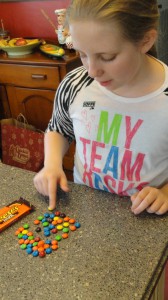 With the passing of Valentine’s Day I hope that you have been able to enjoy a taste of chocolate. You have probably heard by now that chocolate is good for you. Do you believe it? This is a fact that is backed by research. Still most of us can’t help but be concerned about how something so sweet might adversely impact our health. Chocolate lovers, even those at risk for developing type II diabetes or hypertension, many now have a legitimate reason to indulge in this culinary pleasure.
With the passing of Valentine’s Day I hope that you have been able to enjoy a taste of chocolate. You have probably heard by now that chocolate is good for you. Do you believe it? This is a fact that is backed by research. Still most of us can’t help but be concerned about how something so sweet might adversely impact our health. Chocolate lovers, even those at risk for developing type II diabetes or hypertension, many now have a legitimate reason to indulge in this culinary pleasure.
A study reported in the American Journal of Clinical Nutrition tested the effects of dark and while chocolate on healthy adults to determine whether either type played a role in blood pressure and insulin sensitivity. They concluded that dark chocolate can indeed help reduce blood pressure and insulin resistance. White chocolate did not provide these health benefits. The effects of dark chocolate are due to flavanols, antioxidant compounds also found in many fruits and vegetables that have been shown to lower risk of heart disease. Flavonols make dark chocolate in moderation a great solution to satisfy your sweet tooth!
Keep in mind that although dark chocolate has health benefits, most chocolate bars are high in saturated fat, so moderation is key. Also, eating dark chocolate cannot substitute for everyday healthy food choices. Nor can chocolate replace regular exercise or medications that have been prescribed by your physician. Still, it’s nice to know you can indulge in your chocolate cravings every so often without feeling guilty about it.
The Project, Land and People, Resources for Learning that is available through the Florida Ag in the Classroom program has a great lesson, Loco for Cocoa that gives the background of chocolate as well as various activities for youth in grades 6-12.
Acres of Adventures Afterschool Curriculum produced by National 4-H has a M&M Mystery Challenge as well as the following link has M&M Math Worksheets: http://www.4-h.org/resource-library/curriculum/4-h-afterschool-agriculture/acres-of-adventures-1/#BookMark2
Ag in the Classroom, Illinois Farm Bureau has an educational brochure, Candy – Culture and Creativity that I found on the National 4H website under the Acres of Adventures page.
The website Science Kids at http://www.sciencekids.co.nz/videos/chemistry/chocolate.html has a video showing the Science of Chocolate. At the top of the page there is a link to experiments, one of which is Melting Chocolate, which can be done with youth.
In researching activities centered around chocolate I found quite a few team building games that relate to chocolate.
Explore with your 4-H members all the yummy things about chocolate, I think you will find that you enjoy the topic as much as they will.
Source: Dark Chocolate Benefits by Sherri Gampel and Linda B. Bobroff, UF/IFAS document FAR8057.





